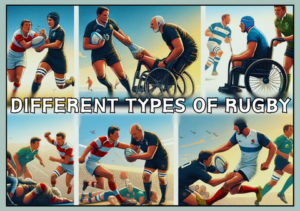Rugby Six Nations is an annual international rugby union competition that brings together six European nations – England, France, Ireland, Italy, Scotland, and Wales – to battle it on the rugby field.
What is the Rugby Six Nations?
The Rugby Six Nations is an annual rugby union competition. It is between six European nations: England, France, Ireland, Italy, Scotland, and Wales.
How is the Rugby Six Nations structured?
Each team plays the other five teams once, for a total of five matches per team. The team with the most points at the end of the tournament is crowned the Six Nations champion.
When is the Rugby Six Nations held?
The Rugby Six Nations is held annually between February and March.
What is a Grand Slam in the Six Nations?
A Grand Slam is when a team wins all of their matches in the Six Nations, meaning they have defeated all other teams in the tournament.
Which stadium has the largest capacity for Rugby Six Nations matches?
The Stade de France in Paris, France. It has the largest capacity for Rugby Six Nations matches, with a seating capacity of 81,338.
Rugby Six Nations
The tournament, which started in 1883 as the Home Nations Championship and later evolved into the Five Nations Championship before becoming the Six Nations in 2000, is one of the world’s oldest and most prestigious rugby competitions.
It’s a showcase of some of the best rugby talent on the planet, with each team fiercely competing for the coveted championship title. From the nail-biting matches to the passionate crowds, Rugby Six Nations is a thrilling spectacle that captures the hearts of rugby fans worldwide.
What are the six nations?
The Six Nations annual rugby union tournament features six European nations – England, France, Ireland, Italy, Scotland, and Wales. Each nation has a distinct flag that represents their identity and heritage, in game it is six nations flags.

It all began in 1883 when England, Scotland, Wales, and Ireland came together to form the Home Nations Championship, which was contested annually until 1909. In 1910, France joined the tournament, becoming known as the Five Nations Championship. Italy joined in 2000, making it the Six Nations we know today.
To get into the Six Nations, a nation must first earn the right to compete through sports performance. This usually involves playing in a lower-tiered competition and working their way up the ranks.
Once a nation is deemed good enough to compete, they are invited to join the Six Nations, where they will face some of the toughest rugby opposition in the world. This is what are the 6 nations.
Six Nations Rugby History
Six nations history dates back to 1883 when the Home Nations Championship was formed. It was consisting of England, Scotland, Wales, and Ireland.

The tournament was contested annually until 1909, after which it was suspended due to political tensions between England and the other nations. It was revived in 1910 when France joined the competition and became known as the Five Nations Championship.
The tournament continued to be played annually, with occasional interruptions due to world wars, until Italy joined in 2000 to form the Six Nations Championship.
The tournament has since become one of the most prestigious rugby competitions in the world, attracting a huge following of fans and generating significant revenue for the participating nations.
Over the years, the Six Nations has seen many memorable moments and legendary players, such as Martin Johnson, Brian O’Driscoll, and Sergio Parisse.

The Six Nations is not just a tournament but a celebration of rugby and European culture. It’s a chance for nations to unite and showcase their talent, passion, and pride on the rugby field.
The tournament continues to evolve and adapt to new challenges, but its rich history and legacy will remain part of its enduring appeal. All these nations have to face each other in this competition and that is what makes it exciting.
Six Nations Winners
All six participants were six nations winners of the Six Nations Championship since its inception in 2000. England, the most successful team in the tournament’s history, has won it seven times, including a Grand Slam in 2016.
Wales has also had great success in the tournament, winning it five times, most recently in 2019. That year, they won a Grand Slam by defeating all five of their opponents, including a hard-fought victory over England in Cardiff.

Ireland has won the tournament four times, including a Grand Slam in 2009. And they has been consistently competitive in recent years. They faced off against England in the 2018 tournament finale, winning 24-15 to clinch the title.
France, who joined the tournament in 1910, has won it five times, most recently in 2010. That year, they defeated England 12-10 in a closely contested match in Paris.
Scotland, who have won the tournament three times, have struggled in recent years but have shown improvement. Their most recent triumph came in 1999 when they defeated Wales 33-20 in the final match.
Italy, the newest addition to the tournament, has yet to win the championship but has made significant strides in recent years. They have come close several times, including a narrow 23-20 loss to France in 2011.

The Six Nations Championship showcases the best rugby talent in Europe, and each team brings its unique style and character to the competition. With fierce rivalries and thrilling matches, it’s always an exciting and unpredictable spectacle.
How is the Six Nations Championship tournament Structured?
The Six Nations Championship is a round-robin tournament featuring the six participating nations: England, Scotland, Wales, Ireland, France, and Italy.
Each team plays the other five once, with three home matches and two away matches or vice versa. The team with the most points at the end of the tournament is crowned the champion.
Teams are awarded four points for a win, two points for a draw, and zero points for a loss. In addition, teams can earn bonus points for scoring four or more tries in a match . Also losing by seven points or fewer. These bonus points can be crucial in determining the tournament’s final standings.

In a tie in the final standings, the team with the better points difference is declared the winner. It is the difference between points scored and points conceded. If the points difference is also tied, the team that scored the most tries is declared the winner.
With each match carrying significant importance, the Six Nations Championship is a high-stakes and fiercely competitive tournament, with every team vying for the champion title. The intensity of the matches is what makes it a world-class competition.
Conclusion
Now you know what are the six nations, 6 nations winners and six nations rugby history. The Six Nations Championship is a thrilling and prestigious rugby tournament. It is featuring some of the best teams and players in the world. With a rich history and a fiercely competitive structure, it truly showcases European rugby culture.
As fans, we can look forward to another exciting tournament filled with unforgettable moments and fierce rivalries. So, let’s gear up, get ready to cheer on our favorite teams, and enjoy the the Six Nations Championship. It is going to be exciting as usual. There is always something new that comes up each time.





